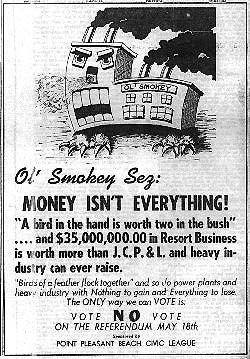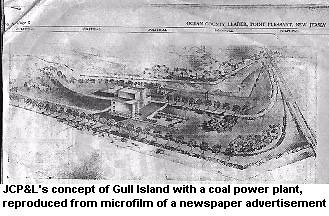| Point Pleasant Beach
residents vs. JCP&L The defeat of a power plant Fearing it would change the area for ever from a resort to an industrial center, in 1954 residents banded together to kill a plan for an electrical generating station on the Manasquan Inlet. Timelines | Pt. Pleasant Historical Society | Pt. Pleasant History | Images | Sites | Books | Tidbits | End | Send Mail  Point Pleasant Beach was a community on the move in 1954. The post-war
building boom was on. The Garden State Parkway opened, making the area
easily accessible to north Jersey tourists and commuters. New Jersey
Bell announced it would bring dial phone service to the area. But
probably the most significant event of the year was the defeat of a
development proposal.
Point Pleasant Beach was a community on the move in 1954. The post-war
building boom was on. The Garden State Parkway opened, making the area
easily accessible to north Jersey tourists and commuters. New Jersey
Bell announced it would bring dial phone service to the area. But
probably the most significant event of the year was the defeat of a
development proposal.
Jersey Central Power and Light Company announced intentions to build a coal-fired electric generating plant on Gull Island. Public opposition killed the plan and the town remained a resort, rather than becoming an industrial area. The 35-acre island is located in the Manasquan River, just north of Channel Drive and is entirely within Point Pleasant Beach. It can be seen well by looking toward the ocean from the Route 35 bridge between Point Pleasant Beach and Brielle. In 1954 the island was owned by JCP&L, which said it was the only practical location for a badly needed power plant at the shore because it met three key requirements: access to large volumes of cool changing water, rail facilities to bring in fuel and a close proximity to the heaviest demands for electric service. The power company pledged to use all the latest protective devices to insure "utmost cleanliness" and to use every precaution in handling fuel. Gull Island would be filled in and landscaped into a park, complete with grass, trees and a promenade, JCP&L said. The actual power building was to be "modern in every respect and will be architecturally designed to conform to the character of the area." The plant will bring additional year-round employment to the area and increased buying power to residents, the pitch went. Point Pleasant Beach could lower its tax rate by fifty percent, as the power plant would add $300,000 in yearly tax revenue to local coffers, JCP&L said. The company released an architect's drawing of a benign looking facility in a park-like setting. The publicity offensive did not work. Power plant foes united to a degree perhaps never equaled in the area before or since. The Point Pleasant Civic League was formed to mobilize opposition and adopted the slogan "Let's keep Point Pleasant Pleasant." The proposed generating station was dubbed "Ol' Smokey." One letter to the editor of the Ocean County Leader noted the architect's drawing neglected to show fuel storage. "What about the coal pile?" it asked. "Can that be properly landscaped?" The writer theorized the plant would need 270 freight cars in a train more than two miles long coming in town every day for fuel. With power plants and heavy industry going together, construction would mean the industrialization of Point Pleasant Beach and the end of the tourism industry, the Civic League charged.
As the controversy raged JCP&L president E.H. Werner charged "A campaign of fear, smear and intimidation has been carried on against acceptance of this power station. Fears have been substituted for facts — fiction for truth — pressure for persuasion — and what is worse, business men have been threatened with boycott." On the day of decision, May 18, 1954, there was a record turnout in Point Pleasant Beach for a special non-binding referendum. Asked if they wanted the electricity station in their town, voters said no by a margin of 1054 to 432. The number of people voting exceeded the turnout for the Eisenhower presidential election two years before. Although the vote did not have the force of law, the issue had been decided. Municipal officials (who had to grant several permits for the project to proceed, including a variance for the height of the smoke stacks) had said before the vote they would abide by the people's choice. Eventually Ocean County got its new electric station. The Oyster Creek nuclear plant was built in Lacey Township. JCP&L in effect met its three criteria for plant placement there. There was access to cooling water. Rail transportation was not needed, because coal has been replaced by nuclear fuel. And the facility was built close to where the largest demands for fuel would be as Ocean County's center for development shifted south and west. While community leaders had opposed a generating station on Gull Island, they were generally not opposed to development. In September of 1954 the Civic League suggested a major marina be constructed and there was talk of forming a port authority. In 1969 a group of Philadelphia-based investors bought the island and announced ambitious plans for a housing, marina, hotel and restaurant complex. Gull Island, which was originally much smaller and all marshland, has been built up over the last seven decades through the dumping of dredge spoils. But for all the plans over the years, that is the extent to which it has been developed. It is now protected from commercial use as part of the Ocean County Park System. It and the Fisherman's Cove land on the north side of the river, which was recently acquired by the Monmouth County Parks System, are now the only undeveloped lands along Manasquan Inlet.
— By Jeff Heim
Timelines | Pt. Pleasant Historical Society | Pt. Pleasant History | Images | Sites | Books | Tidbits | Top | Send Mail |
 Jersey
Central maintained there could be no harm to marine life because there
would be no discharge of waste into the water. It did, however, plan to
use inlet water for cooling purposes. Although the threat of thermal
pollution was not generally understood in 1954, the problem was to
become a serious one at the nuclear power plant that was later built in
Lacey Township.
Jersey
Central maintained there could be no harm to marine life because there
would be no discharge of waste into the water. It did, however, plan to
use inlet water for cooling purposes. Although the threat of thermal
pollution was not generally understood in 1954, the problem was to
become a serious one at the nuclear power plant that was later built in
Lacey Township.